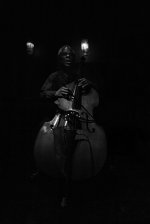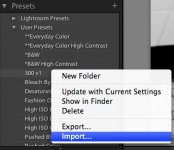Actually, it prints fairly well. Most recently, I printed it on Ilford Gold Fibre Silk, and with [a little] sharpening, I am fairly happy with it. It's hard to take a bad photo of this bass player, Walter Savage, originally from San Francisco, and now here in Arkansas [Thought he deserved a plug]. Actually, I like the version with the sharpening [more than I'd used in the original post-processed version] added.
Here is another shot in the same club. i.e. 1250 - 2 1/3 EV, which I am coming to consider as on the ragged edge. I find I am getting a bit better results with these ratings than by increasing to i.e. 2500 - 1 1/3, although in this light, it seems to not matter. The "gesture" and the sense of the moment for these young musicians seems more important. 28mm Summicron @ f2. Shutter speed probably 1/24 sec.
Thanks to all for their comments.
Norm









